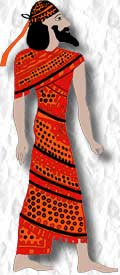Men's Fashions by Francesco |
| Phoenicians: the People of Purple Posted: 30 Aug 2009 08:01 AM PDT  The New York Times has reported that 1 in 17 men living today on the coasts of North Africa and southern Europe have a direct, male-line Phoenician ancestor. The New York Times has reported that 1 in 17 men living today on the coasts of North Africa and southern Europe have a direct, male-line Phoenician ancestor.Phoenician expert Salim George Khalaf, with whom I have recently become acquainted, is one such descendant. But who were they? The Phoenicians were great seafarers—an ancient maritime power—and the direct forefathers of modern-day Lebanon. Experts like Sanford Holst conclude that the Phoenicians emerged from the Canaanite peoples of the Levant, forming their society about 3200 BC in Byblos (present-day Jbeil, Lebanon). For millennia, the Phoenicians sailed throughout the Mediterranean, not as invaders but as peaceful traders. About 1100 BC, they began setting up colonies along the coasts and on islands like Sicily, Sardinia, Ischia, and Mallorca. Their most illustrious colony, however, was undoubtedly Carthage. But Sardinia was attractive to the Phoenicians for the extraction of metals and ores. In the 8th century BC, the Phoenicians founded the Sardinian colonies of Nora, Karalis (Cagliari), Sulci, and Tharros. Situated on the Bay of Oristano, Tharros is now an open-air museum of ongoing excavation with one section submerged under the sea. While historians often state that the foundations of Western Society rest on the ancient pillars of Rome and Greece, many have sadly overlooked the sturdy pillar of the ancient Phoenicians. Phoenician culture profoundly impacted the Mediterranean in the areas of trade, religion, language, and the alphabet, which is the ancestor of most modern alphabets today! Forerunners to a global economy, the intercultural spirit, and the concept of networking, the Phoenicians traded in metals, glass, wood, spices, and jewels. They even perfected the art of dog breeding. Their main industry, however, was textiles. Sometimes referred to as the "purple people," the Phoenicians extracted a purple dye from the shells of sea snails called Murex. So notable were the Phoenicians for this Tyrian purple powder that they obtained their name from the ancient Greek word for purple—phoinikois.  Typically, Phoenician men wore a type of skirt that extended from the waist to the knees, closely resembling the Egyptian shenti. The upper body was clothed in a close-fitting tunic with elboe-length sleeves. At times, a full-body robe with folds or pleats was worn underneath. Typically, Phoenician men wore a type of skirt that extended from the waist to the knees, closely resembling the Egyptian shenti. The upper body was clothed in a close-fitting tunic with elboe-length sleeves. At times, a full-body robe with folds or pleats was worn underneath.Gracefully draped in folds, mantles could be thrown over one shoulder, reaching as far as the knee. Borders of garments for the upper class were often embroidered. Phoenician men sported large pendants, armlets, bracelets, and signet rings, as well as ornamental metalic collars similar to the Egyptians. Preferring long curly hair and beards with no mustaches, the men sported cone-shaped caps. Photo top right, Phoenician dress, Public Domain. Photo bottom left, Phoenician dress, Copyright Phoenica.org. |
| You are subscribed to email updates from Men's Fashion by Francesco To stop receiving these emails, you may unsubscribe now. | Email delivery powered by Google |
| Google Inc., 20 West Kinzie, Chicago IL USA 60610 | |

















